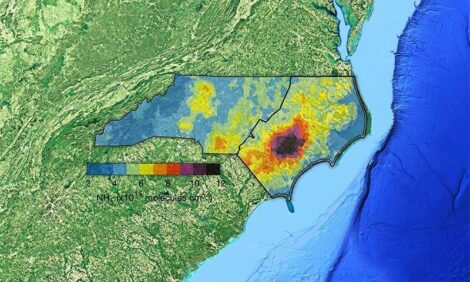



US Pork Outlook Report - March 2006
By U.S.D.A., Economic Research Service - This article is an extract from the March 2006: Livestock, Dairy and Poultry Outlook Report, highlighting Global Pork Industry data.
Hogs/Pork
Pork production forecasts for 2006 remain unchanged at 21.215 billion
pounds. First quarter prices of live equivalent 51-52 percent lean hogs are expected
to average $42 and $43 per cwt. U.S. pork exports for January were more than 20
percent larger than in January 2005.
Stand-out markets for U.S. pork in January
were Mexico, Russia, and South Korea. Through the first week of March,
preliminary swine import data shows that total imports are about 7 percent higher
than the same period last year, with feeder pigs/iso-wean animals accounting for a
greater share.
January Pork Exports Skyrocket
U.S. exporters kicked off 2006 in spectacular fashion by shipping more than 231
million pounds of pork to foreign markets in January, a quantity about 20 percent
higher than in January of last year. Only two countries of the “usual” set of
importing countries did not increase their year-over-year purchases of U.S. pork:
Japan and Romania.
Total Japanese 2006 pork imports are expected to slow more
than 10 percent from last year, primarily because 2005 imports were so large that by
year’s end Japan’s pork stocks-to-use ratio was much higher than usual. Romania’s
January imports of 478,000 pounds were the lowest monthly total since January
2004, when Romanian imports of U.S. pork began to be noticeable each month.
Reasons for lower Romanian demand for U.S. pork products are unclear, but overall
they were more than balanced by higher U.S. sales elsewhere.
Higher pork exports are largely attributable to attractive U.S pork prices and to a
fairly sharp drop-off in the value of the U.S. dollar, making prices to foreign
customers even more attractive.

Mexico has historically been the second-most-important foreign market for U.S.
pork. And while 2005 was no exception to this trend, last year witnessed a slow
down in the rate of growth of Mexican demand for U.S. pork. U.S. exports to
Mexico last year were only about 1 percent above 2004 shipments. January 2006
exports to Mexico suggest, however, that the period of slow growth could be over.
Mexican imports of U.S. pork in January were more than 30 percent above January
2005. The Mexican economy is expected to expand at an annual rate of 3-4 percent
this year, suggesting that consumers’ family budgets could include more meat
products. Large supplies of lower priced U.S. broiler products could pressure
Mexican demand for U.S. pork this year, however.
Russia was another “stand-out” market in January. Large Russian purchases of
attractively priced U.S. pork products likely substituted in part for Brazilian pork
and beef products, currently banned from Russia because of recent outbreaks of
Foot and Mouth Disease in three southern Brazilian states. It is also possible that
Russian consumers are eating more pork due to anxieties associated with recent
outbreaks of Avian Influenza. Russia has allocated to the United States a tariff rate
quota for pork of almost 156 million pounds in 2006. Last year U.S. exporters
shipped about 93 million pounds of pork to Russia.
Pork Imports Open Year on a Steady Note
U.S. pork imports were 86.4 million pounds in January, about 2.5 percent higher
than January of 2005. Eighty percent of January imports were of Canadian origin,
11 percent came from Denmark, and most of the balance came from other EU
nations, mainly the Netherlands and Poland. It appears that U.S. importers will
continue to favor Canadian pork products. In 1995, Canada accounted for 68
percent of U.S. imports and Denmark accounted for 22 percent. Over time the
Canadian pork industry has developed, cross border trade relationships have
evolved, and transport costs have escalated. In 2005 Canada’s share of U.S. imports
was 82 percent, while Denmark’s share declined to less than 10 percent.

Feeder Pigs Account for Higher Share of Larger Swine Imports
U.S. buyers imported 719,881 head of Canadian swine into the United States tin
January, more than 7 percent above January 2005 imports. The feeder pig
component of January imports was 67 percent, versus 65 percent last year. These
import levels, released monthly by the U.S. Commerce Department, comport with
weekly import data published by USDAAgricultural Marketing Service.
The
weekly data show that through the first week of March, total swine imports were
running almost 7 percent above the same period a year ago. Cumulative Canadian
Federal and Provincial slaughter through March 4 was off by 5 percent compared
with a year ago. More feeder pigs and fewer slaughter ready hogs are coming to the
United States this year. The United States is expected to import 8.6 million head of
Canadian swine this year, about 68 percent of which are expected to be feederisowean
animals.
Links
For more information view the full Livestock, Dairy and Poultry Outlook - March 2006 (pdf)Source: Livestock, Dairy and Poultry Outlook - U.S. Department of Agriculture, Economic Research Service - March 2006







